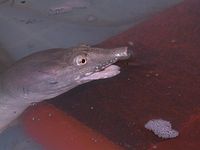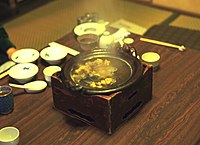This is an old revision of this page, as edited by Village Idiot Sabant (talk | contribs) at 09:09, 30 November 2008 (→Characteristics: Philippines). The present address (URL) is a permanent link to this revision, which may differ significantly from the current revision.
Revision as of 09:09, 30 November 2008 by Village Idiot Sabant (talk | contribs) (→Characteristics: Philippines)(diff) ← Previous revision | Latest revision (diff) | Newer revision → (diff)
| Trionychidae | |
|---|---|

| |
| Chinese Softshelled Turtle Pelodiscus sinensis | |
| Scientific classification | |
| Kingdom: | Animalia |
| Phylum: | Chordata |
| Class: | Reptilia |
| Subclass: | Anapsida |
| Order: | Testudines |
| Suborder: | Cryptodira |
| Superfamily: | Trionychoidea |
| Family: | Trionychidae Fitzinger, 1826 |
| Subfamilies | |
Trionychidae is a taxonomic family which comprises a number of turtle genera commonly known as soft-shell turtles. It consists of some of the world's largest fresh water turtles, though many can adapt to living in highly brackish areas. Members of this family occur in Africa, Asia, North America, and the East Indies. North American members of genus Trionyx were fairly recently assigned the new genus name Apalone, though they are still listed semi-correctly as Trionyx in some texts.
Characteristics
They are called "soft shelled" because their carapace lacks horny scutes (scales), though the Spiny Softshell Turtle, Apalone spinifera, does have some scale-like projections, hence its name. The carapace is leathery and pliable, particularly at the sides. The central part of the carapace has a layer of solid bone beneath it, as in other turtles, but this is absent at the outer edges. Some species also have dermal bones in the plastron, but these are not attached to the bones of the shell. The light and flexible shell of these turtles allows them to move more easily in open water, or in muddy lake bottoms.
Females can grow up to several feet in carapace diameter, while males stay much smaller; this is their main form of sexual dimorphism. Pelochelys cantorii, found in southeastern Asia, is the largest softshell turtle on earth.

These turtles have many characteristics pertaining to their aquatic lifestyle. Like all aquatic turtles, they need to be submerged to be able to swallow food. Most are strict carnivores, with diets consisting mainly of fishes, aquatic crustaceans, snails, amphibians, and sometimes birds and small mammals. They have elongated, soft, snorkel-like nostrils. Their necks are disproportionately long in comparison to their body size, enabling them to breathe surface air while their bodies remain submerged in the substrate (mud or sand) a foot or more below the surface.
Like some amphibians and marine snakes, softshell turtles are able to extract a small amount of oxygen out of water via their skin, further enabling them to stay underwater for prolonged periods. Their feet are webbed and are three-clawed, hence the "Tri-" in the genus name. The carapace color of each type of softshell turtle tends to match the sand and/or mud color of its geographical region, assisting in their "lie and wait" feeding methodology.
Soft-Shelled Turtles look rather helpless but are fully able to protect them-selves in time of danger. "Hidden by the lips, are a pair of mandibles remarkably keen and strong; on many specimens the mandibles form the outer border of powerful crushing processes- the alveolar surfaces of the jaws; examples thus provided feed largely on mollusks. Taken at a disadvantage, out of the water, the soft-shelled turtles are savage fighters. the head darts at an offending object like that of a snake. Large turtles are dangerous; for they can amputate a man's finger- possibly his hand."
The Philippines had these rare species on 2001, but it was only this year that a juvenile Cantor’s Soft-Shelled Turtle known as “cagot" appeared and was captured by a fisherman along the Addalam River, Cabarroguis, Quirino, Isabela. On 2001, this turtle was sent to Chicago, and later confirmed to be an endangered turtle specie.
Soft-shell turtles as food

Soft-shell turtles are eaten as a delicacy in most parts of their range, particularly in East Asia.
In the United States, "harvesting" them is legal in Florida. Environmental groups have been advocating with the authorities for banning, or restricting, the practice. The Florida Fish and Wildlife Conservation Commission responded by introducing the daily limit of 20 turtles per day for licensed harvesters - the level which the turtles advocates consider unsustainable, as there maybe anywhere between 100 to 500 hunters state-wide. While some catch is consumed locally, most is exported; the Commission estimates (2008) that around 3,000 pounds of softshell turtles are exported each week via Tampa International Airport.
Taxonomy
Family Trionychidae
- Palaeotrionyx (extinct)
- Subfamily Cyclanorbinae
- Genus Cyclanorbis
- Genus Cycloderma
- Genus Lissemys
- Subfamily Trionychinae
- Genus Amyda
- Genus Apalone
- Genus Aspideretes
- Genus Chitra
- Genus Dogania
- Genus Nilssonia
- Genus Palea
- Genus Pelochelys
- Genus Pelodiscus
- Genus Rafetus
- Genus Trionyx
Notes
- ^ Obst, Fritz Jurgen (1998). Cogger, H.G. & Zweifel, R.G. (ed.). Encyclopedia of Reptiles and Amphibians. San Diego: Academic Press. pp. 117–118. ISBN 0-12-178560-2.
{{cite book}}: CS1 maint: multiple names: editors list (link) - King, Peter and Harold Heatwole (1994) Partitioning of Aquatic Oxygen Uptake among Different Respiratory Surfaces in a Freely Diving Pleurodiran Turtle, Elseya latisternum. Copeia, 3:802-806
- Ditmars
- gmanews.tv/story, After seven years, rare soft-shelled turtle resurfaces in Quirino Province
- news.yahoo.com, After seven years, rare soft-shelled turtle resurfaces in Quirino Province
- "China Gobbling Up Florida Turtles", By CRAIG PITTMAN, St. Petersburg Times. Published: Thursday, October 9, 2008
References
Parade of the Animal Kingdom. Hegner, Robert. 1935. the Macmillan Company.
This article about a turtle is a stub. You can help Misplaced Pages by expanding it. |